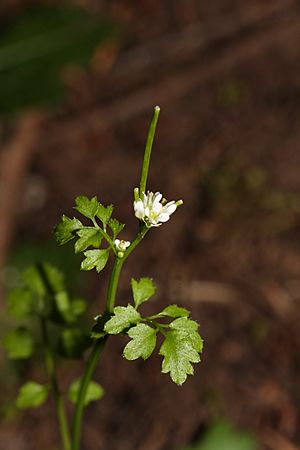Little western bittercress facts for kids
Quick facts for kids Cardamine oligosperma |
|
|---|---|
 |
|
| Scientific classification |
Cardamine oligosperma is a small plant. It is commonly known as the little western bittercress. This plant is native to western North America. You can find it growing from Alaska all the way down to California and over to Colorado. It usually grows in damp places in the mountains.
What Does Little Western Bittercress Look Like?
The little western bittercress is a type of herb. It can be an annual plant, meaning it lives for just one year. Or, it can be a biennial plant, which means it lives for two years. It grows from a main root called a taproot. Think of a carrot; that's a good example of a taproot!
This plant often has one or more stems that grow straight up. These stems can also have branches. Its leaves are quite interesting. They are divided into many smaller parts called leaflets. The plant usually has a group of leaves at its base. These leaves form a circle, like a small rose, and their leaflets are almost round.
The plant's flowers grow in a cluster called an inflorescence. This cluster can be several centimeters long. It holds many tiny white flowers. Each flower has petals that are only a few millimeters long. After the flowers, the plant produces a fruit. This fruit is a long, thin pod called a silique. It can grow up to 2.5 centimeters long.
Can You Eat Little Western Bittercress?
Yes, you can eat parts of the little western bittercress! Its leaves are safe to eat raw. Other soft parts of the plant can also be cooked. Sometimes, these tender parts are eaten raw too. It's like a wild vegetable!

